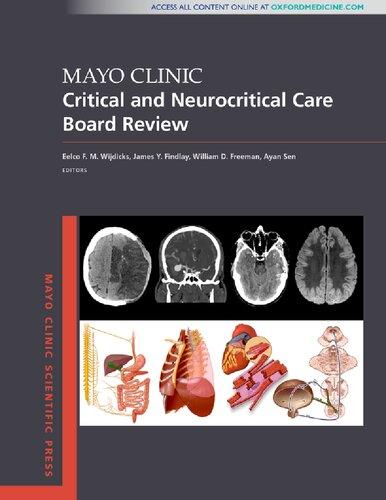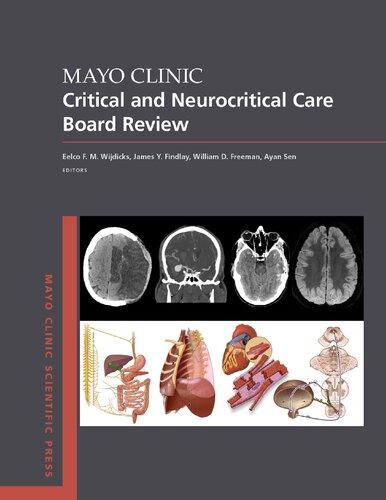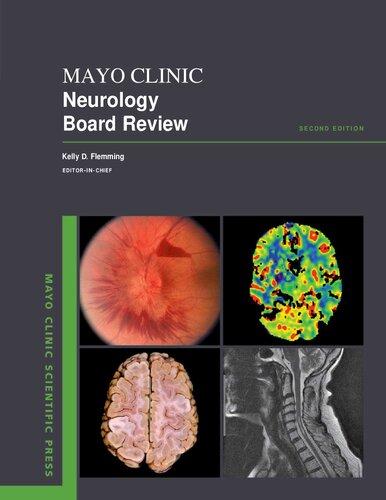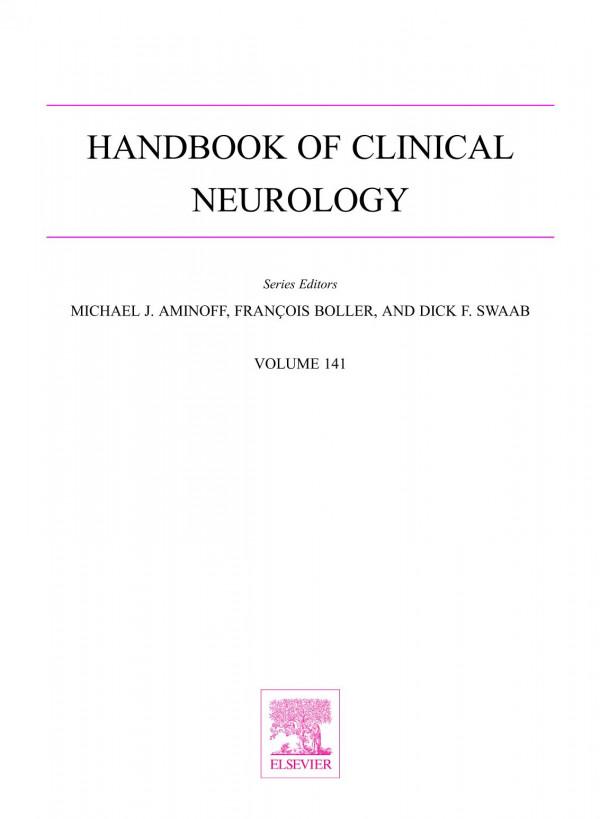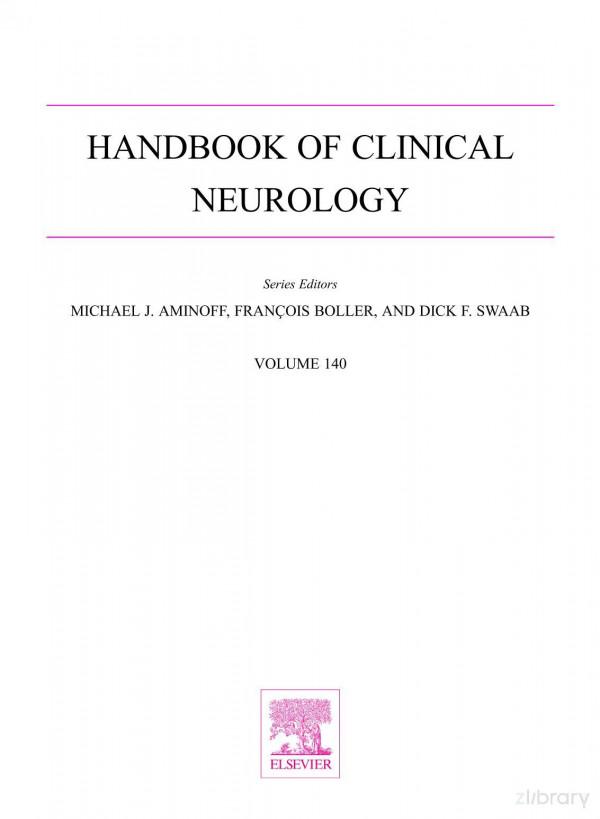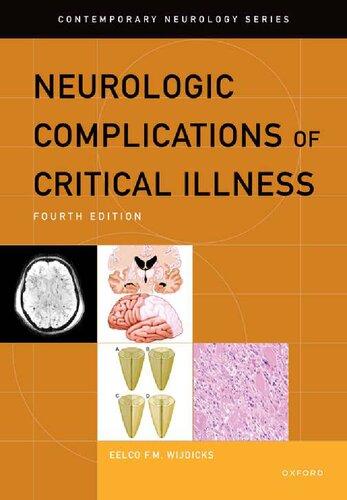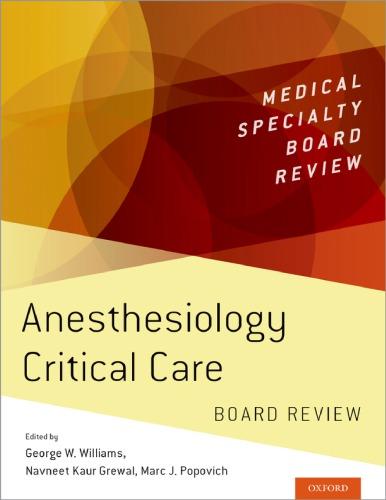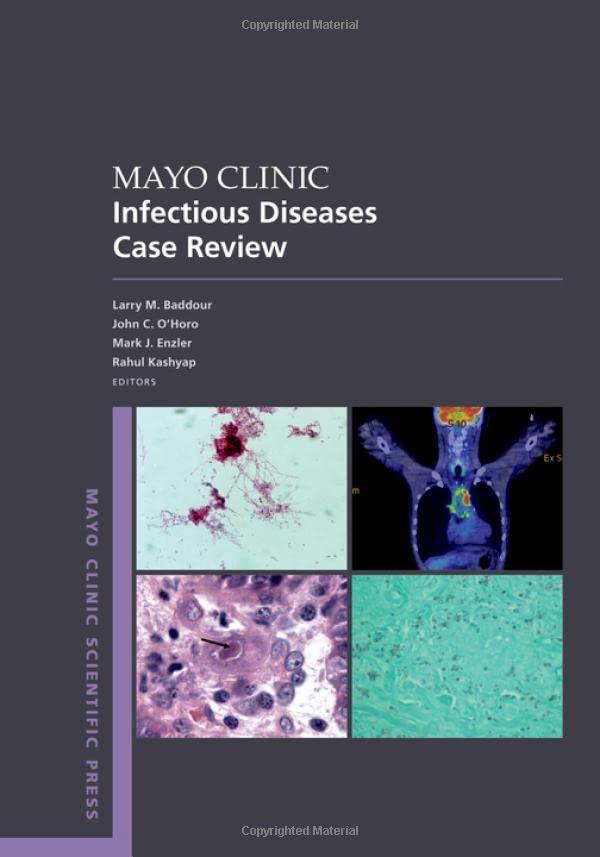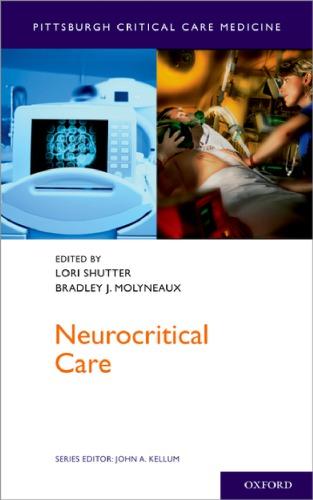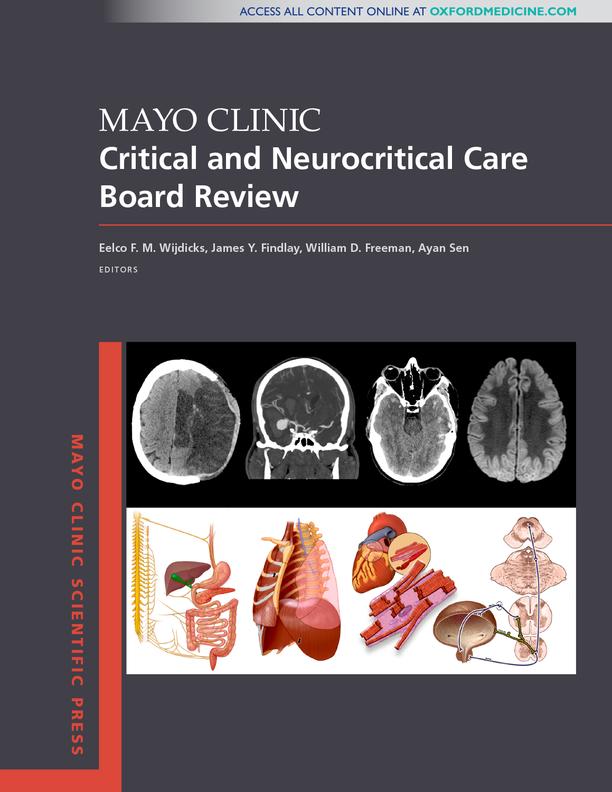Table of Contents
Contributors xiii
Section I: Fundamentals of Critical Care
1 • Respiratory Physiology in Critical Illness 3
Minkyung Kwon, MD and Jose L. Diaz-Gomez, MD
2 • Mechanical Ventilation: Basic Modes 10
Amelia A. Lowell, RRT, RCP
3 • Mechanical Ventilation: Advanced Modes 17
Amelia A. Lowell, RRT, RCP and Bhavesh M. Patel, MD
4
• Cardiovascular System in the Critically Ill Patient 26
Juan G. Ripoll Sanz, MD; Norlalak Jiramethee, MD; and Jose L. Diaz-Gomez, MD
5 • Renal Function in Critically Ill Patients 35
Pramod K. Guru, MBBS, MD
6 • Nutrition in Critical Illness 42
Angela N. Vizzini, RDN, LD/N and Mireille H. Hamdan, RDN, LD/N
Section I: Questions and Answers 50
Section II: Fundamentals of Neurocritical Care
7 • Neurologic Examination in Neurocritical Illness 61
Eelco F. M. Wijdicks, MD, PhD
8 • Intracranial Pressure 69
Eelco F. M. Wijdicks, MD, PhD and William D. Freeman, MD
9 • Cerebrospinal Physiology 74
Joseph Zachariah, MD
10
• Cerebral Circulation and Cerebral Blood Flow 79
Arnoley S. Abcejo, MD and Jeffrey J. Pasternak, MD
11
• Consequences of Anoxia and Ischemia to the Brain 86
Jennifer E. Fugate, DO
12
• Consequences of Acute Metabolic Changes to the Brain 92
Sherri A. Braksick, MD and Sara E. Hocker, MD
13
• Consequences of Acute Hypertension to the Brain 97
Katherine M. Oshel, MD and Hani M. Wadei, MD
14 • Coma and Other Altered States of Consciousness 101
Eelco F. M. Wijdicks, MD, PhD
15 • Neuromuscular Respiratory Failure 109
Maximiliano A. Hawkes, MD and Eelco F. M. Wijdicks, MD, PhD
16 • Neurogenic Breathing Patterns 115
Eelco F. M. Wijdicks, MD, PhD
17 • Neurogenic Cardiac Manifestations 118
Sherri A. Braksick, MD and Eelco F. M. Wijdicks, MD, PhD
18 • Paroxysmal Sympathetic Hyperactivity 122
Kevin T. Gobeske, MD, PhD
Section II: Questions and Answers 125
Section III: Critical Care Disorders
Pulmonary Disorders
19 • Acute Respiratory Distress Syndrome 137
Richard K. Patch III, MD and James Y. Findlay, MB, ChB
20
• Pulmonary Embolism: An Overview 142
Brandon T. Nokes, MD and Rodrigo Cartin-Ceba, MD
21
• Asthma in the Critically Ill Patient 150
Jonathan J. Danaraj, DO and Augustine S. Lee, MD
22
• Chronic Obstructive Pulmonary Disease
Exacerbation 157
Isabel Mira-Avendano, MD and Minkyung Kwon, MD
23
• Pleural Diseases in Critical Care Medicine 161
Karthika R. Linga, MBBS and Neal M. Patel, MD
24
• Pulmonary Malignancy 166
Ali A. Zaied, MD and Margaret M. Johnson, MD
25
• Pulmonary Hypertension and Right-Sided Heart Failure in the Critically Ill 171
Charles D. Burger, MD
Circulatory and Cardiovascular Disorders
26
• Anaphylaxis and Anaphylactic Shock 179
Megan S. Motosue, MD and Gerald W. Volcheck, MD
27
• Cardiogenic Shock 183
Robert A. Ratzlaff, DO and Jason L. Siegel, MD
28
• Acute Coronary Syndrome 190
Siva S. Ketha, MD and Juan Carlos Leoni Moreno, MD
29
• Cardiac Rhythm and Conduction Disturbances 197
30
31
Yahaira Ortiz Gonzalez, MD and Fred Kusumoto, MD
• Hypertensive Emergencies 207
Denzil R. Hill, MD and James A. Onigkeit, MD
• Cardiopulmonary Resuscitation 211
Richard K. Patch III, MD
32 • Vascular Emergencies of the Aorta 216
Tariq Almerey, MD; January F. Moore; and Houssam Farres, MD
Acute Endocrine Disorders
33 • Pituitary Apoplexy 225
Sherri A. Braksick, MD
34 • Diabetes Insipidus 229
Dana Erickson, MD
35 • Panhypopituitarism 234
Diane Donegan, MB, BCh and Irina Bancos, MD
36 • Thyroid Disorders in the Intensive Care Unit 239
John E. Moss, MD
37 • Glycemic Control in Neurocritically Ill Patients 241
Carla P. Venegas-Borsellino, MD; Michael A. Pizzi, DO, PhD; and Santiago Naranjo-Sierra, MD
38 • Adrenal Insufficiency in Neurocritically Ill Patients 246
Carla P. Venegas-Borsellino, MD and Santiago Naranjo-Sierra, MD
Gastrointestinal Disorders
39 • Acute Gastrointestinal Hemorrhage 253
Pablo Moreno Franco, MD and Philip E. Lowman, MD
40 • Paralytic and Obstructive Ileus 259
Juan M. Canabal, MD
41 • Acute Liver Failure 264
James Y. Findlay, MB, ChB and Eelco F. M. Wijdicks, MD, PhD
42 • Acute Perforations of the Gastrointestinal Tract 270
Levan Tsamalaidze, MD and John A. Stauffer, MD
43 • Acute Vascular Disorders of the Intestine 276
Omar Y. Mousa, MBBS and Surakit Pungpapong, MD
44 • Abdominal Compartment Syndrome 281
Daniel J. Johnson, MD
Renal Disorders
45 • Acute Kidney Injury 287
Ankit Sakhuja, MBBS and Kianoush B. Kashani, MD
46 • Acid-Base Disorders 294
Onur Demirci, MD
47 • Drug Dosing in Renal Failure 299
Daniel A. Jackson, PharmD, RPh
48 • Principles of Renal Replacement Therapies 302
Peter M. Fitzpatrick, MD
49 • Disorders of Water and Electrolyte Balance 306 Yuzana Zaw, MBBS and Mira T. Keddis, MD
Hematologic and Inflammatory Disorders
50 • Anemia and Blood Transfusion 319
Joy D. Hughes, MD; Mariela Rivera, MD; and Myung S. Park, MD, MS
51 • Hematologic and Oncologic Complications in the Intensive Care Unit 325
Carl A. Ruthman, MD and Jose C. Yataco, MD
52 • Thrombocytopenia and Thrombocytopathy 331
Gretchen Johns, MD
53 • Disseminated Intravascular Coagulation: Clinical Diagnosis and Management 337
Prakash Vishnu, MBBS and Sikander Ailawadhi, MD
54 • Diagnosis and Management of Acquired Bleeding Disorders 345
Rajiv K. Pruthi, MBBS
55 • Anticoagulation Monitoring and Reversal 353
Theresa N. Kinard, MD
56 • Therapeutic Plasma Exchange for Acute Hematologic Disorders 359
Jill Adamski, MD, PhD
57 • Rheumatologic and Autoimmune Emergencies 363
Megan L. Krause, MD and Kevin G. Moder, MD
Sepsis and Other Infectious Diseases
58 • Infectious Diseases Complicating Critical Care 369
David A. Sotello Aviles, MD and Walter C. Hellinger, MD
59 • Antibiotics in the Intensive Care Unit 375
David A. Sotello Aviles, MD and Walter C. Hellinger, MD
60 • Sepsis and Septic Shock 381
Charles R. Sims III, MD and Thomas B. Comfere, MD
Dermatologic Concerns
61 • Dermatologic Emergencies in the Intensive Care Unit 391
Matthew R. Hall, MD
Trauma and Burns
62 • Initial Approach to the Management of Multisystem Trauma 397
David S. Morris, MD
63 • Chest and Abdominal Trauma 402
Joy D. Hughes, MD and David S. Morris, MD
64 • Skeletal Trauma 405
Joshua S. Bingham, MD and Kevin J. Renfree, MD
65 • Burns and Electrical Injuries 409
Brandon T. Nokes, MD and Ayan Sen, MD
Cardiothoracic Critical Care
66 • Cardiothoracic Surgery and Postoperative Intensive Care 417
Juan G. Ripoll Sanz, MD and Robert A. Ratzlaff, DO
67 • Mechanical Circulatory Assist Devices 424
Ayan Sen, MD and Bhavesh M. Patel, MD
68 • Extracorporeal Membrane Oxygenation 429
J. Kyle Bohman, MD and Gregory J. Schears, MD
69 • Cardiac Pacing in the Intensive Care Unit 435 J. William Schleifer, MD; Farouk Mookadam, MB, BCh; and Harish Ramakrishna, MD
Transplant Critical Care
70
• Clinical Management of Heart Transplant Recipients 443
Arzoo Sadiqi, BS and Jama Jahanyar, MD, PhD
71
• Critical Care of Heart-Lung and Lung Transplant Recipients 446
Ramachandra R. Sista, MD
72
• Clinical Management of Liver Transplant Recipients 453
Bhargavi Gali, MD
73
• Clinical Management of Kidney Transplant Recipients 457
James A. Onigkeit, MD
74
• Small Intestinal Transplant 460
Ayan Sen, MD
Toxicity and Toxins
75 • Serotonin Syndrome 467
Kevin T. Gobeske, MD, PhD and Eelco F. M. Wijdicks, MD, PhD
76
• Neuroleptic Malignant Syndrome and Hyperthermia 472
J. Ross Renew, MD and Monica Mordecai, MD
77
• Clinical Toxicology: Selected Drugs of Abuse and Chemical and Biological Warfare Agents 475
Matthew D. Sztajnkrycer, MD, PhD
Section III: Questions and Answers 483
Section IV: Neurocritical Illness
Acute Cerebrovascular Disorders
78
• Diagnosis and Management of Hemispheric Infarction 543
Sanjeet S. Grewal, MD and Benjamin L. Brown, MD
79
• Basilar Artery Occlusion 547
Michael R. Pichler, MD and Jennifer E. Fugate, DO
80
• Carotid Artery Disease 555 Nnenna Mbabuike, MD and Rabih G. Tawk, MD
81
• Adult Primary Central Nervous System Vasculitis 563
Carlo Salvarani, MD; Robert D. Brown Jr, MD, MPH; and Gene G. Hunder, MD
82
• Intracerebral and Intraventricular Hemorrhage 570 Oana Dumitrascu, MD and Maria I. Aguilar, MD
83
• Aneurysmal Subarachnoid Hemorrhage 577
Giuseppe Lanzino, MD and Biagia La Pira, MD
84
• Intracranial Arteriovenous Malformations 585
Kelly D. Flemming, MD and Michael J. Link, MD
85
• Cerebral Venous and Dural Sinus Thrombosis 594
Sara E. Hocker, MD
86 • Cervical Arterial Dissection 600
Bart M. Demaerschalk, MD
Traumatic Brain and Spine Injury
87 • Traumatic Brain Injury and Spinal Cord Injury 605
Maya A. Babu, MD
88 • Traumatic Epidural and Subdural Hematomas 614
Patrick R. Maloney, MD and Michelle J. Clarke, MD
89 • Unstable Spinal Fractures 621
William E. Clifton III, MD and Mark A. Pichelmann, MD
Acute Central Nervous System Infections
90 • Encephalitis 629
Allen J. Aksamit Jr, MD
91 • Acute Bacterial Meningitis 637
Eelco F. M. Wijdicks, MD, PhD
92 • Brain Abscess and Spinal Epidural Abscess 642
Selby G. Chen, MD
Acute Neuromuscular Disorders
93 • Myasthenia Gravis 651
Maximiliano A. Hawkes, MD and Eelco F. M. Wijdicks, MD, PhD
94 • Guillain-Barré Syndrome 658
Eelco F. M. Wijdicks, MD, PhD
95 • Amyotrophic Lateral Sclerosis 664
Jennifer M. Martinez-Thompson, MD and Nathan P. Staff, MD, PhD
96 • Rhabdomyolysis and Toxic Myopathies 670
Justin C. Kao, MB, ChB and Margherita Milone, MD, PhD
97 • Myopathy and Neuropathy Acquired in the Intensive Care Unit 677
Priya S. Dhawan, MD and Jennifer A. Tracy, MD
Miscellaneous Disorders of Acute Brain Injury
98 • Status Epilepticus 687
Christopher P. Robinson, DO, MS and Sara E. Hocker, MD
99 • Posterior Reversible Encephalopathy Syndrome 693
Sudhir V. Datar, MBBS and Jennifer E. Fugate, DO
100 • Demyelinating Disorders of the Central Nervous System 699
Aurelia A. Smith, MD and Brian G. Weinshenker, MD
101 • Rapidly Progressive Dementia and Coma 704
Prasuna Kamireddi, MBBS; Jason L. Siegel, MD; and Dennis W. Dickson, MD
Neuro-oncology
102 • Brain and Spine Tumors 715
Mithun Sattur, MBBS; Matthew E. Welz, MS; and Bernard R. Bendok, MD
103 • Neoplastic Meningitis 722
Alyx B. Porter, MD
104 • Autoimmune Encephalitis 726
Eslam Shosha, MB, BCh and Sean J. Pittock, MD
105 • Radiation Therapy 734
Sameer R. Keole, MD
Postoperative Neurosurgery
106 • Intensive Care After Spinal Surgery 739
Clarence B. Watridge, MD
107 • Intensive Care After Craniotomy 746
Kelly Gassie, MD; Belinda G. Bradley, APRN; Robert E. Wharen Jr, MD; and Betty Y. S. Kim, MD, PhD
108 • Intensive Care After Neuroendovascular Procedures 753
Mithun Sattur, MBBS; Chandan Krishna, MD; Bernard R. Bendok, MD; and Brian W. Chong, MD
Section IV: Questions and Answers 759
Section V: Imaging in Critical Illness
109 • Radiography and Computed Tomography of the Chest 785
Barbara L. McComb, MD
110 • Abdominal Radiography 797
Joseph G. Cernigliaro, MD and David J. DiSantis, MD
111 • Fluoroscopy: Principles and Safety 805
David M. Sella, MD; Glenn M. Sturchio, PhD; and Beth A. Schueler, PhD
112 • Ultrasonography 809
Santiago Naranjo-Sierra, MD and Lauren K. Ng Tucker, MD
113 • Transesophageal Echocardiography 816
Ryan C. Craner, MD; Farouk Mookadam, MB, BCh; and Harish Ramakrishna, MD
Section V: Questions and Answers 827
Section VI: Procedures
Airway Procedures and Modes of
Ventilation
114 • Basics of Airway and Oxygen Delivery Devices 835
Andrew W. Murray, MD
115 • Endotracheal Intubation Procedures 840
Matthew J. Ritter, MD
116
• Noninvasive Positive Pressure Ventilation 846
Karen W. Hampton, MS, RRT
117 • Tracheostomy 850
Saba Ghorab, MD and David G. Lott, MD
118 • Diagnostic and Interventional Bronchoscopy in the Intensive Care Unit 855
Cesar A. Keller, MD
Cardiovascular and Cardiopulmonary
Monitoring and Access
119 • Electrocardiographic Monitoring 865
Pragnesh P. Parikh, MD and K. L. Venkatachalam, MD
120 • Hemodynamic Monitoring 870
Hannelisa E. Callisen, PA-C;
Stacy L. Libricz, PA-C, MS; and Ayan Sen, MD
121
• Pulmonary Artery Catheterization 879
Philip E. Lowman, MD
122 • Thoracentesis and Chest Tubes 883
Staci E. Beamer, MD
123
• Central Line Placement 890
Nicholas D. Will, MD and W. Brian Beam, MD
124 • Interventional Radiology Procedures 892
Rahmi Oklu, MD, PhD
Neuromonitoring and Procedures
125 • Intracranial Pressure Monitoring and External Ventricular Drainage 899
Maya A. Babu, MD and John L. D. Atkinson, MD
126 • Lumbar Puncture 903
Christina C. Smith, APRN
127 • Lumbar Drain 907
Jamie J. Van Gompel, MD
128 • Intraventricular Drug Administration 912
William W. Horn Jr, APRN and Benjamin L. Brown, MD
129 • Transcranial Doppler Ultrasonography 914
Mark N. Rubin, MD
130 • Electroencephalography 918
Amy Z. Crepeau, MD
131 • Essentials of Multimodal Brain Monitoring 925
Jennifer E. Fugate, DO
132 • Essentials of Cranial Neuroimaging 932
E. Paul Lindell, MD
Section VI: Questions and Answers 941
Section VII: Pharmacotherapeutics
133 • Anticonvulsant Drugs 955
Anteneh M. Feyissa, MD and Jeffrey W. Britton, MD
134 • Effects of Targeted Temperature Management on Drugs 963
Lauren K. Ng Tucker, MD
135 • Sedation and Analgesia 967
Juan G. Ripoll Sanz, MD and Jose L. Diaz-Gomez, MD
136 • Inotropes, Vasopressors, and Antihypertensive Agents 972
Juan N. Pulido, MD
137 • Antibiotics, Antivirals, and Antifungals 981
David A. Sotello Aviles, MD and Walter C. Hellinger, MD
Section VII: Questions and Answers 990
Section VIII: Ethics in the Neurointensive Care Unit
138 • Palliative and End-of-Life Care in the Intensive Care Unit 997
Maisha T. Robinson, MD
139 • Communicating With Families 1001
Cory Ingram, MD
140 • Brain Death 1005
Eelco F. M. Wijdicks, MD, PhD
141 • Minimally Conscious State and Persistent Vegetative State 1008
David T. Jones, MD
142 • Ethical Concerns and Care Before Organ Donation 1012
Diane C. McLaughlin, APRN and
Lauren K. Ng Tucker, MD
Section VIII: Questions and Answers 1015
Index 1019
Contributors
Arnoley S. Abcejo, MD
Senior Associate Consultant, Department of Anesthesiology and Perioperative Medicine, Mayo Clinic, Rochester, Minnesota; Assistant Professor of Anesthesiology, Mayo Clinic College of Medicine and Science
Jill Adamski, MD, PhD
Chair, Division of Laboratory Medicine, Mayo Clinic Hospital, Phoenix, Arizona; Associate Professor of Laboratory Medicine and Pathology, Mayo Clinic College of Medicine and Science
Maria I. Aguilar, MD
Consultant, Department of Neurology, Mayo Clinic, Scottsdale, Arizona; Associate Professor of Neurology, Mayo Clinic College of Medicine and Science
Sikander Ailawadhi, MD
Consultant, Division of Hematology and Oncology, Mayo Clinic, Jacksonville, Florida; Associate Professor of Medicine, Mayo Clinic College of Medicine and Science
Allen J. Aksamit Jr, MD
Consultant, Department of Neurology, Mayo Clinic, Rochester, Minnesota; Professor of Neurology, Mayo Clinic College of Medicine and Science
Tariq Almerey, MD
Research Fellow in Surgery, Mayo Clinic School of Graduate Medical Education, Mayo Clinic College of Medicine and Science, Jacksonville, Florida
John L. D. Atkinson, MD
Consultant, Department of Neurologic Surgery, Mayo Clinic, Rochester, Minnesota; Professor of Neurosurgery, Mayo Clinic College of Medicine and Science
Maya A. Babu, MD
Resident in Neurosurgery, Mayo Clinic School of Graduate Medical Education, Mayo Clinic College of Medicine and Science, Rochester, Minnesota
Present address: Harvard Medical School, Boston, Massachusetts
Irina Bancos, MD
Consultant, Division of Endocrinology, Diabetes, Metabolism, & Nutrition, Mayo Clinic, Rochester, Minnesota; Assistant Professor of Medicine, Mayo Clinic College of Medicine and Science
W. Brian Beam, MD
Consultant, Department of Anesthesiology and Perioperative Medicine, Mayo Clinic, Rochester, Minnesota; Assistant Professor of Anesthesiology, Mayo Clinic College of Medicine and Science
Staci E. Beamer, MD
Senior Associate Consultant, Department of Cardiovascular and Thoracic Surgery, Mayo Clinic Hospital, Phoenix, Arizona; Assistant Professor of Surgery, Mayo Clinic College of Medicine and Science
Bernard R. Bendok, MD
Chair, Department of Neurologic Surgery, Mayo Clinic Hospital, Phoenix, Arizona; Professor of Neurosurgery, Mayo Clinic College of Medicine and Science
Joshua S. Bingham, MD
Fellow in Reconstructive Surgery, Mayo Clinic School of Graduate Medical Education and Instructor in Orthopedics, Mayo Clinic College of Medicine and Science, Scottsdale, Arizona
J. Kyle Bohman, MD
Consultant, Department of Anesthesiology and Perioperative Medicine, Mayo Clinic, Rochester, Minnesota; Assistant Professor of Anesthesiology, Mayo Clinic College of Medicine and Science
Belinda G. Bradley, APRN
Lead Nurse Practicioner, Department of Neurologic Surgery, Mayo Clinic, Jacksonville, Florida
Sherri A. Braksick, MD
Fellow in Critical Care Neurology, Mayo Clinic School of Graduate Medical Education, Mayo Clinic College of Medicine and Science, Rochester, Minnesota
Present address: University of Kansas Medical Center, Kansas City, Kansas
Jeffrey W. Britton, MD
Chair, Division of Epilepsy, Mayo Clinic, Rochester, Minnesota; Professor of Neurology, Mayo Clinic College of Medicine and Science
Benjamin L. Brown, MD
Senior Associate Consultant, Department of Neurologic Surgery, Mayo Clinic, Jacksonville, Florida; Assistant Professor of Neurosurgery, Mayo Clinic College of Medicine and Science
Robert D. Brown Jr, MD, MPH
Chair, Division of Stroke and Cerebrovascular Diseases, Mayo Clinic, Rochester, Minnesota; Professor of Neurology, Mayo Clinic College of Medicine and Science
Charles D. Burger, MD
Consultant, Division of Pulmonary, Allergy, and Sleep Medicine, Mayo Clinic, Jacksonville, Florida; Professor of Medicine, Mayo Clinic College of Medicine and Science
Hannelisa E. Callisen, PA-C
Physician Assistant, Department of Critical Care Medicine, Mayo Clinic Hospital, Phoenix, Arizona
Juan M. Canabal, MD
Senior Associate Consultant, Department of Transplantation, Mayo Clinic, Jacksonville, Florida; Assistant Professor of Medicine, Mayo Clinic College of Medicine and Science
Rodrigo Cartin-Ceba, MD
Consultant, Department of Critical Care Medicine, Mayo Clinic, Scottsdale, Arizona; Associate Professor of Medicine, Mayo Clinic College of Medicine and Science
Joseph G. Cernigliaro, MD
Chair, Division of Abdominal Imaging, Mayo Clinic, Jacksonville, Florida; Associate Professor of Radiology, Mayo Clinic College of Medicine and Science
Selby G. Chen, MD
Senior Associate Consultant, Department of Neurologic Surgery, Mayo Clinic, Jacksonville, Florida; Assistant Professor of Neurosurgery, Mayo Clinic College of Medicine and Science
Brian W. Chong, MD
Consultant, Department of Radiology, Mayo Clinic Hospital, Phoenix, Arizona; Associate Professor of Radiology, Mayo Clinic College of Medicine and Science
Michelle J. Clarke, MD
Consultant, Department of Neurologic Surgery, Mayo Clinic, Rochester, Minnesota; Professor of Neurosurgery and of Orthopedics, Mayo Clinic College of Medicine and Science
William E. Clifton III, MD
Resident in Neurologic Surgery, Mayo Clinic School of Graduate Medical Education, Mayo Clinic College of Medicine and Science, Jacksonville, Florida
Thomas B. Comfere, MD
Consultant, Department of Anesthesiology and Perioperative Medicine, Mayo Clinic, Rochester, Minnesota; Assistant Professor of Anesthesiology, Mayo Clinic College of Medicine and Science
Ryan C. Craner, MD
Consultant, Department of Anesthesiology and Perioperative Medicine, Mayo Clinic Hospital, Phoenix, Arizona; Assistant Professor of Anesthesiology, Mayo Clinic College of Medicine and Science
Amy Z. Crepeau, MD
Consultant, Department of Neurology, Mayo Clinic Hospital, Phoenix, Arizona; Assistant Professor of Neurology, Mayo Clinic College of Medicine and Science
Jonathan J. Danaraj, DO
Resident in Pulmonary and Critical Care Medicine, Mayo Clinic School of Graduate Medical Education, Mayo Clinic College of Medicine and Science, Jacksonville, Florida
Sudhir V. Datar, MBBS
Division of Critical Care Neurology, Wake Forest University Medical Center, Winston-Salem, North Carolina; Assistant Professor of Neurology and of Anesthesiology, Wake Forest School of Medicine
Bart M. Demaerschalk, MD
Consultant, Department of Neurology, Mayo Clinic Hospital, Phoenix, Arizona; Professor of Neurology, Mayo Clinic College of Medicine and Science
Onur Demirci, MD
Consultant, Department of Anesthesiology and Perioperative Medicine, Mayo Clinic, Rochester, Minnesota; Assistant Professor of Anesthesiology, Mayo Clinic College of Medicine and Science
Priya S. Dhawan, MD
Resident in Neurology, Mayo Clinic School of Graduate Medical Education, Mayo Clinic College of Medicine and Science, Rochester, Minnesota
Present address: University of British Columbia, Vancouver, British Columbia
Jose L. Diaz-Gomez, MD
Consultant, Departments of Critical Care Medicine, Anesthesiology, and Neurosurgery, Mayo Clinic, Jacksonville, Florida; Associate Professor of Anesthesiology, Mayo Clinic College of Medicine and Science
Present address: Private Practice
Dennis W. Dickson, MD
Consultant, Departments of Laboratory Medicine and Pathology and of Neuroscience, Mayo Clinic, Jacksonville, Florida; Professor of Laboratory Medicine and Pathology, Mayo Clinic College of Medicine and Science
David J. DiSantis, MD
Senior Associate Consultant, Department of Radiology, Mayo Clinic, Jacksonville, Florida; Professor of Radiology, Mayo Clinic College of Medicine and Science
Diane Donegan, MB, BCh
Research Collaborator in Endocrinology, Mayo Clinic School of Graduate Medical Education, Mayo Clinic College of Medicine and Science, Rochester, Minnesota
Oana Dumitrascu, MD
Fellow in Vascular Neurology, Mayo Clinic School of Graduate Medical Education, Mayo Clinic College of Medicine and Science, Scottsdale, Arizona
Dana Erickson, MD
Consultant, Division of Endocrinology, Diabetes, Metabolism, & Nutrition, Mayo Clinic, Rochester, Minnesota; Associate Professor of Medicine, Mayo Clinic College of Medicine and Science
Houssam Farres, MD
Consultant, Division of Vascular Surgery, Mayo Clinic, Jacksonville, Florida; Assistant Professor of Surgery, Mayo Clinic College of Medicine and Science
Anteneh M. Feyissa, MD
Senior Associate Consultant, Department of Neurology, Mayo Clinic, Jacksonville, Florida; Assistant Professor of Neurology, Mayo Clinic College of Medicine and Science
James Y. Findlay, MB, ChB
Consultant, Department of Anesthesiology and Perioperative Medicine, Mayo Clinic, Rochester, Minnesota; Associate Professor of Anesthesiology, Mayo Clinic College of Medicine and Science
Peter M. Fitzpatrick, MD
Consultant, Division of Nephrology and Hypertension, Mayo Clinic, Jacksonville, Florida; Assistant Professor of Medicine, Mayo Clinic College of Medicine and Science
Kelly D. Flemming, MD
Consultant, Department of Neurology, Mayo Clinic, Rochester, Minnesota; Associate Professor of Neurology, Mayo Clinic College of Medicine and Science
William D. Freeman, MD
Consultant, Departments of Critical Care Medicine, Neurology, and Neurosurgery, Mayo Clinic, Jacksonville, Florida; Professor of Neurology and of Neurosurgery, Mayo Clinic College of Medicine and Science
Jennifer E. Fugate, DO
Consultant, Department of Neurology, Mayo Clinic, Rochester, Minnesota; Assistant Professor of Neurology, Mayo Clinic College of Medicine and Science
Bhargavi Gali, MD
Consultant, Department of Anesthesiology and Perioperative Medicine, Mayo Clinic, Rochester, Minnesota; Assistant Professor of Anesthesiology, Mayo Clinic College of Medicine and Science
Kelly Gassie, MD
Resident in Neurologic Surgery, Mayo Clinic School of Graduate Medical Education, Mayo Clinic College of Medicine and Science, Jacksonville, Florida
Saba Ghorab, MD
Resident in Otolaryngology, Mayo Clinic School of Graduate Medical Education, Mayo Clinic College of Medicine and Science, Scottsdale, Arizona
Kevin T. Gobeske, MD, PhD
Resident in Critical Care Neurology, Mayo Clinic School of Graduate Medical Education, Mayo Clinic College of Medicine and Science, Rochester, Minnesota
Sanjeet S. Grewal, MD
Resident in Neurologic Surgery, Mayo Clinic School of Graduate Medical Education, Mayo Clinic College of Medicine and Science, Jacksonville, Florida
Pramod K. Guru, MBBS, MD
Senior Associate Consultant, Department of Critical Care Medicine, Mayo Clinic, Jacksonville, Florida; Assistant Professor of Medicine, Mayo Clinic College of Medicine and Science
Matthew R. Hall, MD
Consultant, Department of Dermatology, Mayo Clinic, Jacksonville, Florida; Assistant Professor of Dermatology, Mayo Clinic College of Medicine and Science
Mireille H. Hamdan, RDN, LD/N
Dietician, Clinical Nutrition Services, Mayo Clinic, Jacksonville, Florida; Instructor in Nutrition, Mayo Clinic College of Medicine and Science
Karen W. Hampton, MS, RRT
Respiratory Therapist, Respiratory Services, Mayo Clinic, Jacksonville, Florida
Maximiliano A. Hawkes, MD
Fellow in Critical Care Neurology, Mayo Clinic School of Graduate Medical Education and Assistant Professor of Neurology, Mayo Clinic College of Medicine and Science, Rochester, Minnesota
Walter C. Hellinger, MD
Chair, Division of Infectious Diseases, Mayo Clinic, Jacksonville, Florida; Associate Professor of Medicine, Mayo Clinic College of Medicine and Science
Denzil R. Hill, MD
Senior Associate Consultant, Department of Anesthesiology and Perioperative Medicine, Mayo Clinic, Rochester, Minnesota; Instructor in Anesthesiology, Mayo Clinic College of Medicine and Science
Sara E. Hocker, MD
Consultant, Department of Neurology, Mayo Clinic, Rochester, Minnesota; Associate Professor of Neurology, Mayo Clinic College of Medicine and Science
William W. Horn Jr, APRN
Nurse Practitioner, Department of Neurologic Surgery, Mayo Clinic, Jacksonville, Florida
Joy D. Hughes, MD
Research Fellow in General Surgery, Mayo Clinic School of Graduate Medical Education, Mayo Clinic College of Medicine and Science, Rochester, Minnesota
Gene G. Hunder, MD
Emeritus Professor of Neurology, Mayo Clinic College of Medicine and Science, Rochester, Minnesota
Cory Ingram, MD
Senior Associate Consultant, Division of Community Palliative Medicine, Mayo Clinic, Rochester, Minnesota; Assistant Professor of Family Medicine and of Palliative Medicine, Mayo Clinic College of Medicine and Science
Daniel A. Jackson, PharmD, RPh
Pharmacist, Pharmacy Services, Mayo Clinic, Jacksonville, Florida; Assistant Professor of Pharmacy, Mayo Clinic College of Medicine and Science
Jama Jahanyar, MD, PhD
Senior Associate Consultant, Department of Cardiovascular and Thoracic Surgery, Mayo Clinic Hospital, Phoenix, Arizona; Assistant Professor of Surgery, Mayo Clinic College of Medicine and Science
Norlalak Jiramethee, MD
Fellow in Critical Care Medicine, Mayo Clinic School of Graduate Medical Education, Mayo Clinic College of Medicine and Science, Jacksonville, Florida
Gretchen Johns, MD
Consultant, Department of Laboratory Medicine and Pathology, Mayo Clinic, Jacksonville, Florida; Assistant Professor of Laboratory Medicine and Pathology, Mayo Clinic College of Medicine and Science
Daniel J. Johnson, MD
Chair, Department of Surgery, Mayo Clinic Hospital, Phoenix, Arizona; Associate Professor of Surgery, Mayo Clinic College of Medicine and Science
Margaret M. Johnson, MD
Consultant, Division of Pulmonary, Allergy and Sleep Medicine, Mayo Clinic, Jacksonville, Florida; Associate Professor of Medicine, Mayo Clinic College of Medicine and Science
David T. Jones, MD
Consultant, Department of Neurology, Mayo Clinic, Rochester, Minnesota; Assistant Professor of Neurology, Mayo Clinic College of Medicine and Science
Prasuna Kamireddi, MBBS
Research Trainee, Department of Neurology, Mayo Clinic, Jacksonville, Florida
Justin C. Kao, MB, ChB
Fellow in Advanced Clinical Neurology, Mayo Clinic School of Graduate Medical Education, Mayo Clinic College of Medicine and Science, Rochester, Minnesota
Kianoush B. Kashani, MD
Consultant, Division of Nephrology and Hypertension, Mayo Clinic, Rochester, Minnesota; Professor of Medicine, Mayo Clinic College of Medicine and Science
Mira T. Keddis, MD
Consultant, Division of Nephrology, Mayo Clinic, Scottsdale, Arizona; Assistant Professor of Medicine, Mayo Clinic College of Medicine and Science
Cesar A. Keller, MD
Emeritus Professor of Medicine, Mayo Clinic College of Medicine and Science, Jacksonville, Florida
Sameer R. Keole, MD
Consultant, Department of Radiation Oncology, Mayo Clinic Hospital, Phoenix, Arizona; Assistant Professor of Radiation Oncology, Mayo Clinic College of Medicine and Science
Siva S. Ketha, MD
Research Collaborator, Mayo Clinic, Jacksonville, Florida; Assistant Professor of Medicine, Mayo Clinic College of Medicine and Science
Betty Y. S. Kim, MD, PhD
Consultant, Department of Neurologic Surgery, Mayo Clinic, Jacksonville, Florida; Associate Professor of Neurosurgery and Assistant Professor of Neuroscience, Mayo Clinic College of Medicine and Science
Theresa N. Kinard, MD
Consultant, Department of Laboratory Medicine, Mayo Clinic Hospital, Phoenix, Arizona; Assistant Professor of Laboratory Medicine and Pathology, Mayo Clinic College of Medicine and Science
Megan L. Krause, MD
Fellow in Rheumatology, Mayo Clinic School of Graduate Medical Education, Mayo Clinic College of Medicine and Science, Rochester, Minnesota
Chandan Krishna, MD
Senior Associate Consultant, Department of Neurologic Surgery, Mayo Clinic Hospital, Phoenix, Arizona; Assistant Professor of Neurosurgery, Mayo Clinic College of Medicine and Science
Fred Kusumoto, MD
Consultant, Department of Cardiovascular Diseases, Mayo Clinic, Jacksonville, Florida; Professor of Medicine, Mayo Clinic College of Medicine and Science
Minkyung Kwon, MD
Resident in Pulmonary and Critical Care Medicine, Mayo Clinic School of Graduate Medical Education, Mayo Clinic College of Medicine and Science, Jacksonville, Florida
Giuseppe Lanzino, MD
Consultant, Departments of Neurologic Surgery and Radiology, Mayo Clinic, Rochester, Minnesota; Professor of Neurosurgery, Mayo Clinic College of Medicine and Science
Biagia La Pira, MD
Research Trainee, Department of Neurologic Surgery, Mayo Clinic, Rochester, Minnesota
Present address: Private Practice, Rome, Italy
Augustine S. Lee, MD
Chair, Division of Pulmonary, Allergy and Sleep Medicine, Mayo Clinic, Jacksonville, Florida; Associate Professor of Medicine, Mayo Clinic College of Medicine and Science
Juan Carlos Leoni Moreno, MD
Consultant, Department of Transplantation, Mayo Clinic, Jacksonville, Florida; Instructor in Medicine, Mayo Clinic College of Medicine and Science
Stacy L. Libricz, PA-C, MS
Physician Assistant, Department of Critical Care Medicine, Mayo Clinic Hospital, Phoenix, Arizona; Instructor in Medicine, Mayo Clinic College of Medicine and Science
E. Paul Lindell, MD
Consultant, Department of Radiology, Mayo Clinic, Rochester, Minnesota; Assistant Professor of Radiology, Mayo Clinic College of Medicine and Science
Karthika R. Linga, MBBS
Fellow in Pulmonary and Critical Care Medicine, Mayo Clinic School of Graduate Medical Education, Mayo Clinic College of Medicine and Science, Jacksonville, Florida
Michael J. Link, MD
Consultant, Department of Neurologic Surgery, Mayo Clinic, Rochester, Minnesota; Professor of Neurosurgery, Mayo Clinic College of Medicine and Science
David G. Lott, MD
Consultant, Department of Otolaryngology-Head & Neck Surgery/Audiology, Mayo Clinic, Scottsdale, Arizona; Associate Professor of Otolaryngology, Mayo Clinic College of Medicine and Science
Amelia A. Lowell, RRT, RCP
Clinical Respiratory Care Specialist, Mayo Clinic Hospital, Phoenix, Arizona; Assistant Professor of Anesthesiology, Mayo Clinic College of Medicine and Science
Philip E. Lowman, MD
Consultant, Department of Critical Care Medicine, Mayo Clinic, Jacksonville, Florida; Instructor in Medicine, Mayo Clinic College of Medicine and Science
Patrick R. Maloney, MD
Research Collaborator, Department of Neurologic Surgery, Mayo Clinic, Rochester, Minnesota
Jennifer M. Martinez-Thompson, MD
Senior Associate Consultant, Department of Neurology, Mayo Clinic, Rochester, Minnesota; Assistant Professor of Neurology, Mayo Clinic College of Medicine and Science
Nnenna Mbabuike, MD
Fellow in Endovascular Neurosurgery, Mayo Clinic School of Graduate Medical Education, Mayo Clinic College of Medicine and Science, Jacksonville, Florida
Present address: University of Pennsylvania Medical Center, Altoona, Pennsylvania
Barbara L. McComb, MD
Emeritus Associate Professor of Radiology, Mayo Clinic College of Medicine and Science, Jacksonville, Florida
Diane C. McLaughlin, APRN
Nurse Practitioner, Department of Neurology, Mayo Clinic, Jacksonville, Florida; Instructor in Neurology, Mayo Clinic College of Medicine and Science
Margherita Milone, MD, PhD
Consultant, Department of Neurology, Mayo Clinic, Rochester, Minnesota; Professor of Neurology, Mayo Clinic College of Medicine and Science
Isabel Mira-Avendano, MD
Consultant, Division of Pulmonary, Allergy and Sleep Medicine, Mayo Clinic, Jacksonville, Florida; Assistant Professor of Medicine, Mayo Clinic College of Medicine and Science
Kevin G. Moder, MD
Consultant, Division of Rheumatology, Mayo Clinic, Rochester, Minnesota; Associate Professor of Medicine, Mayo Clinic College of Medicine and Science
Farouk Mookadam, MB, BCh
Consultant, Department of Cardiovascular Diseases, Mayo Clinic Hospital, Phoenix, Arizona; Professor of Medicine, Mayo Clinic College of Medicine and Science
January F. Moore
Special Project Associate, Division of Vascular Surgery, Mayo Clinic, Jacksonville, Florida
Monica Mordecai, MD
Consultant, Department of Anesthesiology and Perioperative Medicine, Mayo Clinic, Jacksonville, Florida; Assistant Professor of Anesthesiology, Mayo Clinic College of Medicine and Science
Pablo Moreno Franco, MD
Consultant, Department of Transplantation, Mayo Clinic, Jacksonville, Florida; Assistant Professor of Medicine, Mayo Clinic College of Medicine and Science
David S. Morris, MD
Consultant, Division of Trauma, Critical Care, & General Surgery, Mayo Clinic, Rochester, Minnesota
Present address: Intermountain Medical Center, Murray, Utah
John E. Moss, MD
Consultant, Department of Critical Care Medicine, Mayo Clinic, Jacksonville, Florida; Assistant Professor of Medicine, Mayo Clinic College of Medicine and Science
Megan S. Motosue, MD
Resident in Allergy and Immunology, Mayo Clinic School of Graduate Medical Education, Mayo Clinic College of Medicine and Science, Rochester, Minnesota
Omar Y. Mousa, MBBS
Fellow in Gastroenterology and Hepatology, Mayo Clinic School of Graduate Medical Education and Assistant Professor of Medicine, Mayo Clinic College of Medicine and Science, Jacksonville, Florida
Andrew W. Murray, MD
Consultant, Department of Anesthesiology and Perioperative Medicine, Mayo Clinic Hospital, Phoenix, Arizona; Assistant Professor of Anesthesiology, Mayo Clinic College of Medicine and Science
Santiago Naranjo-Sierra, MD
Visiting Research Fellow in Department of Critical Care Medicine, Mayo Clinic, Jacksonville, Florida
Present address: Hospital Pablo Tobon Uribe, Medellín, Colombia
Lauren K. Ng Tucker, MD
Consultant, Department of Critical Care Medicine, Mayo Clinic, Jacksonville, Florida; Assistant Professor of Medicine, Mayo Clinic College of Medicine and Science
Brandon T. Nokes, MD
Resident in Internal Medicine, Mayo Clinic School of Graduate Medical Education, Mayo Clinic College of Medicine and Science, Scottsdale, Arizona
Rahmi Oklu, MD, PhD
Chair, Division of Interventional Radiology, Mayo Clinic Hospital, Phoenix, Arizona; Professor of Radiology, Mayo Clinic College of Medicine and Science
James A. Onigkeit, MD
Consultant, Department of Anesthesiology and Perioperative Medicine, Mayo Clinic, Rochester, Minnesota; Assistant Professor of Anesthesiology, Mayo Clinic College of Medicine and Science
Yahaira Ortiz Gonzalez, MD
Resident in Cardiovascular Diseases, Mayo Clinic School of Graduate Medical Education, Mayo Clinic College of Medicine and Science, Jacksonville, Florida
Katherine M. Oshel, MD
Consultant, Division of Nephrology and Hypertension, Mayo Clinic, Jacksonville, Florida; Instructor in Medicine, Mayo Clinic College of Medicine and Science
Pragnesh P. Parikh, MD
Consultant, Department of Cardiovascular Diseases, Mayo Clinic, Jacksonville, Florida; Assistant Professor of Medicine, Mayo Clinic College of Medicine and Science
Myung S. Park, MD, MS
Consultant, Department of Surgery, Mayo Clinic, Rochester, Minnesota; Associate Professor of Surgery, Mayo Clinic College of Medicine and Science
Jeffrey J. Pasternak, MD
Chair, Division of Neuroanesthesia, Mayo Clinic, Rochester, Minnesota; Associate Professor of Anesthesiology, Mayo Clinic College of Medicine and Science
Richard K. Patch III, MD
Consultant, Department of Anesthesiology and Perioperative Medicine and Division of Critical Care Medicine, Mayo Clinic, Rochester, Minnesota; Assistant Professor of Anesthesiology and of Medicine, Mayo Clinic College of Medicine and Science
Bhavesh M. Patel, MD
Consultant, Department of Critical Care Medicine, Mayo Clinic Hospital, Phoenix, Arizona; Assistant Professor of Anesthesiology, of Medicine, and of Neurology, Mayo Clinic College of Medicine and Science
Neal M. Patel, MD
Consultant, Department of Pulmonary and Critical Care Medicine, Mayo Clinic, Jacksonville, Florida; Instructor in Medicine, Mayo Clinic College of Medicine and Science
Mark A. Pichelmann, MD
Consultant, Department of Neurologic Surgery, Mayo Clinic, Jacksonville, Florida; Assistant Professor of Neurosurgery, Mayo Clinic College of Medicine and Science
Michael R. Pichler, MD
Fellow in Cerebrovascular Neurology, Mayo Clinic School of Graduate Medical Education, Mayo Clinic College of Medicine and Science, Rochester, Minnesota
Sean J. Pittock, MD
Consultant, Department of Neurology, Mayo Clinic, Rochester, Minnesota; Professor of Neurology, Mayo Clinic College of Medicine and Science
Michael A. Pizzi, DO, PhD
Fellow in Critical Care Medicine, Mayo Clinic School of Graduate Medical Education, Mayo Clinic College of Medicine and Science, Jacksonville, Florida
Alyx B. Porter, MD
Consultant, Department of Neurology, Mayo Clinic Hospital, Phoenix, Arizona; Assistant Professor of Neurology, Mayo Clinic College of Medicine and Science
Rajiv K. Pruthi, MBBS
Consultant, Divisions of Hematology, Hematopathology, and Laboratory Genetics and Genomics, Mayo Clinic, Rochester, Minnesota; Associate Professor of Medicine, Mayo Clinic College of Medicine and Science
Juan N. Pulido, MD
Consultant, Department of Anesthesiology, Mayo Clinic, Rochester, Minnesota
Present address: Private practice, Seattle, Washington
Surakit Pungpapong, MD
Consultant, Department of Gastroenterology and Hepatology, Mayo Clinic, Jacksonville, Florida; Associate Professor of Medicine, Mayo Clinic College of Medicine and Science
Harish Ramakrishna, MD
Consultant, Department of Anesthesiology and Perioperative Medicine, Mayo Clinic Hospital, Phoenix, Arizona; Professor of Anesthesiology, Mayo Clinic College of Medicine and Science
Robert A. Ratzlaff, DO
Consultant, Departments of Critical Care Medicine and Anesthesiology and Perioperative Medicine, Mayo Clinic, Jacksonville, Florida; Assistant Professor of Anesthesiology, Mayo Clinic College of Medicine and Science
J. Ross Renew, MD
Consultant, Department of Anesthesiology and Perioperative Medicine, Mayo Clinic, Jacksonville, Florida; Assistant Professor of Anesthesiology, Mayo Clinic College of Medicine and Science
Kevin J. Renfree, MD
Consultant, Department of Orthopedic Surgery, Mayo Clinic Hospital, Phoenix, Arizona; Associate Professor of Orthopedics, Mayo Clinic College of Medicine and Science
Juan G. Ripoll Sanz, MD
Resident in Anesthesiology, Mayo Clinic School of Graduate Medical Education, Mayo Clinic College of Medicine and Science, Jacksonville, Florida
Matthew J. Ritter, MD
Consultant, Department of Anesthesiology and Perioperative Medicine, Mayo Clinic, Rochester, Minnesota; Assistant Professor of Anesthesiology, Mayo Clinic College of Medicine and Science
Mariela Rivera, MD
Consultant, Department of Surgery, Mayo Clinic, Rochester, Minnesota; Assistant Professor of Surgery, Mayo Clinic College of Medicine and Science
Christopher P. Robinson, DO, MS
Fellow in Neurocritical Care, Mayo Clinic School of Graduate Medical Education, Mayo Clinic College of Medicine and Science, Rochester, Minnesota
Present address: Department of Neurology and Neurocritical Care Division, University of Florida, Gainesville, Florida
Maisha T. Robinson, MD
Consultant, Department of Neurology, Mayo Clinic, Jacksonville, Florida; Assistant Professor of Neurology, Mayo Clinic College of Medicine and Science
Mark N. Rubin, MD
Fellow in Vascular Neurology, Mayo Clinic School of Graduate Medical Education, Mayo Clinic College of Medicine and Science, Scottsdale, Arizona
Present address: North Shore Neurological Institute, Glenview, Illinois
Carl A. Ruthman, MD
Resident in Pulmonary and Critical Care Medicine, Mayo Clinic School of Graduate Medical Education, Mayo Clinic College of Medicine and Science, Jacksonville, Florida
Arzoo Sadiqi, BS
Research Trainee, Department of Cardiovascular and Thoracic Surgery, Mayo Clinic Hospital, Phoenix, Arizona
Ankit Sakhuja, MBBS
Fellow in Critical Care Medicine, Mayo Clinic School of Graduate Medical Education, and Assistant Professor of Medicine, Mayo Clinic College of Medicine and Science, Rochester, Minnesota
Carlo Salvarani, MD
Department of Rheumatology, Azienda Ospedaliera Arcispedale Sante Maria Nuova, Reggio Emilia, Italy
Mithun Sattur, MBBS
Resident in Neurologic Surgery, Mayo Clinic School of Graduate Medical Education, Mayo Clinic College of Medicine and Science, Scottsdale, Arizona
Gregory J. Schears, MD
Consultant, Department of Anesthesiology and Perioperative Medicine, Mayo Clinic, Rochester, Minnesota; Professor of Anesthesiology, Mayo Clinic College of Medicine and Science
J. William Schleifer, MD
Fellow in Cardiovascular Diseases, Mayo Clinic School of Graduate Medical Education, Mayo Clinic College of Medicine and Science, Scottsdale, Arizona
Present address: Department of Internal Medicine, Division of Cardiology, University of Nebraska Medical Center, Omaha, Nebraska
Beth A. Schueler, PhD
Consultant, Department of Radiology, Mayo Clinic, Rochester, Minnesota; Associate Professor of Radiology and Professor of Medical Physics, Mayo Clinic College of Medicine and Science
David M. Sella, MD
Consultant, Department of Radiology, Mayo Clinic, Jacksonville, Florida; Assistant Professor of Radiology, Mayo Clinic College of Medicine and Science
Ayan Sen, MD
Chair, Department of Critical Care Medicine, Mayo Clinic Hospital, Phoenix, Arizona; Assistant Professor of Emergency Medicine and of Medicine, Mayo Clinic College of Medicine and Science
Eslam Shosha, MB, BCh
Research Fellow in Neurology, Mayo Clinic School of Graduate Medical Education, Mayo Clinic College of Medicine and Science, Rochester, Minnesota
Jason L. Siegel, MD
Senior Associate Consultant, Department of Neurology, Mayo Clinic, Jacksonville, Florida; Assistant Professor of Neurology, Mayo Clinic College of Medicine and Science
Charles R. Sims III, MD
Senior Associate Consultant, Department of Anesthesiology and Perioperative Medicine, Mayo Clinic, Rochester, Minnesota; Instructor in Anesthesiology, Mayo Clinic College of Medicine and Science
Ramachandra R. Sista, MD
Senior Associate Consultant, Division of Pulmonary Medicine, Mayo Clinic, Scottsdale, Arizona
Aurelia A. Smith, MD
Fellow in Multiple Sclerosis and Neuroimmunology, Mayo Clinic School of Graduate Medical Education, Mayo Clinic College of Medicine and Science, Rochester, Minnesota
Christina C. Smith, APRN
Nurse Practitioner, Department of Neurologic Surgery, Mayo Clinic, Jacksonville, Florida; Assistant Professor of Neurosurgery, Mayo Clinic College of Medicine and Science
David A. Sotello Aviles, MD
Fellow in Infectious Diseases, Mayo Clinic School of Graduate Medical Education, Mayo Clinic College of Medicine and Science, Jacksonville, Florida
Present address: Texas Tech University Health Sciences Center, Lubbock, Texas
Nathan P. Staff, MD, PhD
Consultant, Department of Neurology, Mayo Clinic, Rochester, Minnesota; Associate Professor of Neurology, Mayo Clinic College of Medicine and Science
John A. Stauffer, MD
Consultant, Department of Surgery, Mayo Clinic, Jacksonville, Florida; Associate Professor of Surgery, Mayo Clinic College of Medicine and Science
Glenn M. Sturchio, PhD
Consultant, Department of Radiology, Mayo Clinic, Jacksonville, Florida; Assistant Professor of Physiology, Mayo Clinic College of Medicine and Science
Matthew D. Sztajnkrycer, MD, PhD
Consultant, Department of Emergency Medicine, Mayo Clinic, Rochester, Minnesota; Professor of Emergency Medicine, Mayo Clinic College of Medicine and Science
Rabih G. Tawk, MD
Consultant, Department of Neurologic Surgery, Mayo Clinic, Jacksonville, Florida; Associate Professor of Neurosurgery, Mayo Clinic College of Medicine and Science
Jennifer A. Tracy, MD
Consultant, Department of Neurology, Mayo Clinic, Rochester, Minnesota; Assistant Professor of Neurology, Mayo Clinic College of Medicine and Science
Levan Tsamalaidze, MD
Visiting Research Fellow in Surgery, Mayo Clinic School of Graduate Medical Education, Mayo Clinic College of Medicine and Science, Jacksonville, Florida
Jamie J. Van Gompel, MD
Consultant, Department of Neurologic Surgery, Mayo Clinic, Rochester, Minnesota; Associate Professor of Neurosurgery and Otorhinolaryngology, Mayo Clinic College of Medicine and Science
Carla P. Venegas-Borsellino, MD
Senior Associate Consultant, Department of Critical Care Medicine, Mayo Clinic, Jacksonville, Florida
K. L. Venkatachalam, MD
Consultant, Department of Cardiovascular Diseases, Mayo Clinic, Jacksonville, Florida; Associate Professor of Medicine, Mayo Clinic College of Medicine and Science
Prakash Vishnu, MBBS
Senior Associate Consultant, Division of Hematology and Oncology, Mayo Clinic, Jacksonville, Florida; Assistant Professor of Medicine, Mayo Clinic College of Medicine and Science
Angela N. Vizzini, RDN, LD/N
Director, Clinical Nutrition Services, Mayo Clinic, Jacksonville, Florida; Assistant Professor of Nutrition, Mayo Clinic College of Medicine and Science
Gerald W. Volcheck, MD
Chair, Division of Allergic Diseases, Mayo Clinic, Rochester, Minnesota; Associate Professor of Medicine, Mayo Clinic College of Medicine and Science
Hani M. Wadei, MD
Senior Associate Consultant, Division of Neurology and Hypertension, Mayo Clinic, Jacksonville, Florida; Associate Professor of Medicine, Mayo Clinic College of Medicine and Science
Clarence B. Watridge, MD
Associate Consultant, Department of Neurologic Surgery, Mayo Clinic, Jacksonville, Florida; Associate Professor of Neurosurgery, Mayo Clinic College of Medicine and Science
Present address: Ponte Vedra Beach, Florida
Brian G. Weinshenker, MD
Consultant, Department of Neurology, Mayo Clinic, Rochester, Minnesota; Professor of Neurology, Mayo Clinic College of Medicine and Science
Matthew E. Welz, MS
Research Technologist for Neurosurgery, Mayo Clinic Hospital, Phoenix, Arizona
Robert E. Wharen Jr, MD
Consultant, Department of Neurologic Surgery, Mayo Clinic, Jacksonville, Florida; Professor of Neurosurgery, Mayo Clinic College of Medicine and Science
Eelco F. M. Wijdicks, MD, PhD
Chair, Division of Critical Care Neurology, Mayo Clinic, Rochester, Minnesota; Professor of Neurology, Mayo Clinic College of Medicine and Science
Nicholas D. Will, MD
Resident in Anesthesiology, Mayo Clinic School of Graduate Medical Education, Mayo Clinic College of Medicine and Science, Rochester, Minnesota
Jose C. Yataco, MD
Senior Associate Consultant, Department of Critical Care Medicine, Mayo Clinic, Jacksonville, Florida
Present address: Memphis, Tennessee
Joseph Zachariah, MD
Fellow in Critical Care Neurology, Mayo Clinic School of Graduate Medical Education, Mayo Clinic College of Medicine and Science, Rochester, Minnesota
Present address: Spectrum Hospital, Grand Rapids, Michigan
Ali A. Zaied, MD
Senior Associate Consultant, Department of Pulmonary, Critical Care, and Sleep Medicine, Mayo Clinic Health System—Northwest Wisconsin, Eau Claire, Wisconsin
Yuzana Zaw, MBBS
Fellow in Nephrology and Hypertension, Mayo Clinic School of Graduate Education, Mayo Clinic College of Medicine and Science, Scottsdale, Arizon
